- Analytics
- News and Tools
- Quotes
- Chart and quotes for AUDJPY
CFD Trading Rate Australian Dollar vs Japanese Yen (AUDJPY)
| Date | Rate | Change |
|---|
Related news
-
28.02.2024 19:38AUD/JPY Price Analysis: Bears step in with hourly RSI near oversold area, trend still bullish
- The AUD/JPY is currently trading at around 97.90, reflecting a decrease of 0.55% in Wednesday's session.
- Although the daily RSI MACD on the AUD/JPY hints at fading momentum, buyers continue establishing their upper hand.
- However, the hourly chart indicators suggest stronger selling activity with the RSI venturing into oversold regions.
In Wednesday's session, the AUD/JPY fell to around 97.90, losing 0.55%. The short-term technical outlook hints towards a shift in command from the bears to the bulls while the overall bullish trend remains positive.
On the daily chart, the Relative Strength Index (RSI) for the AUD/JPY pair remains in positive territory, although with a declining trend. Despite the recent dip in the RSI, considering it still sits above the 50 mark, the buying pressure somewhat outweighs the selling pressure in the prevailing market conditions. However, a continuous downtrend, indicated by the RSI's negative slope since its recent peak, signifies a weakening in the buying momentum.
On the other hand, witnessing decreased green bars in the Moving Average Convergence Divergence (MACD) histogram indicates cues for a potential shift in trend. A falling MACD histogram generally means that the positive momentum is dwindling, indicating the sellers might be set to take control.
AUD/JPY daily chart
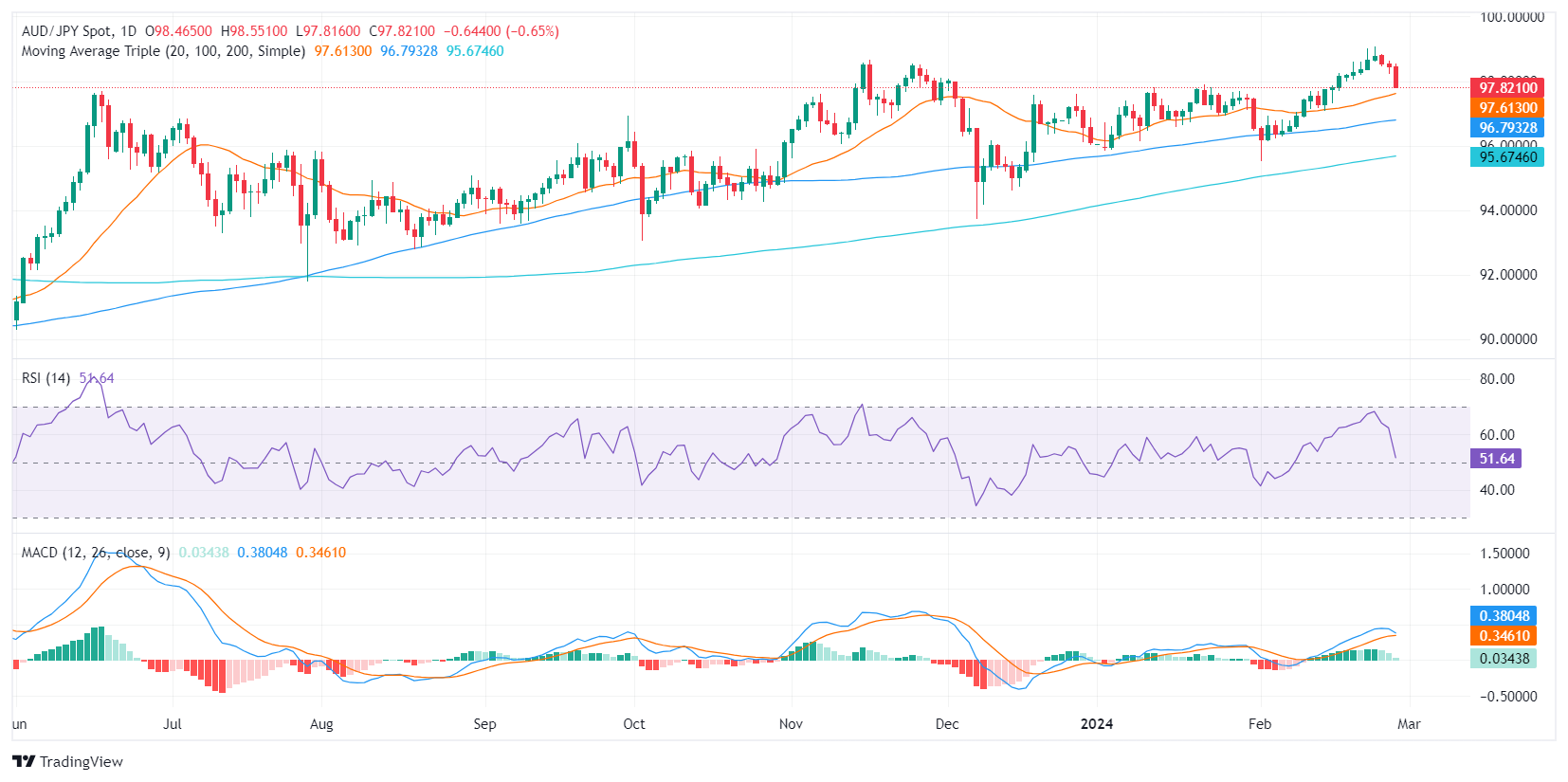
On the hourly chart, the RSI fluctuates in the negative territory, signaling increased selling activity. However, presenting a sharp contrast to the daily chart data, the hourly RSI ventures into the oversold area, which often points to a potential price correction in the near term to the upside. Also, the hourly MACD illustrates a weakening bearish momentum as suggested by the decreasing red bars which may suggest that an upward correction may be incoming..
AUD/JPY hourly chart
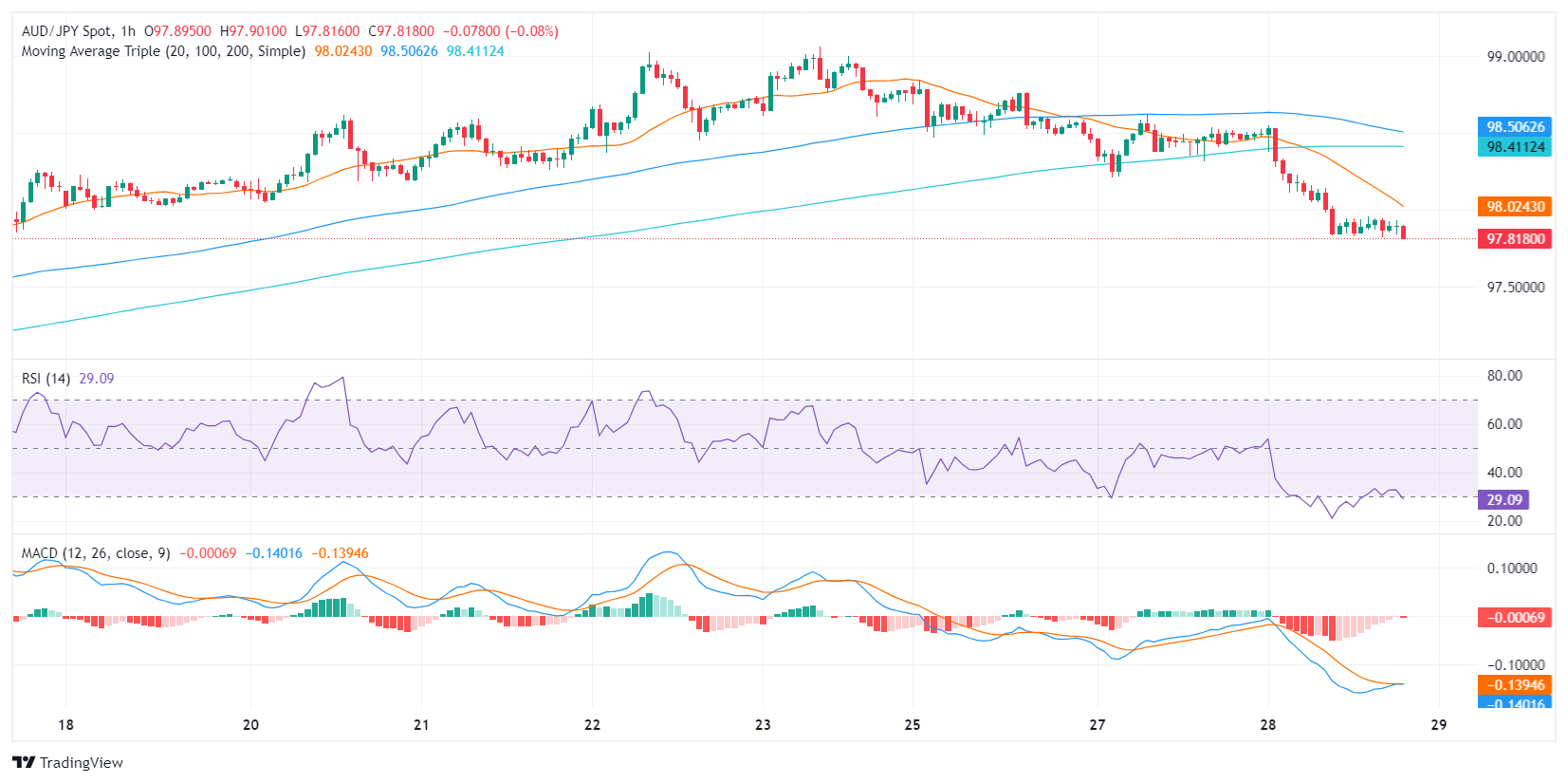
In retrospect, while the daily data illustrates a bullish trend, the hourly data presents that the bears took control but a slight upward correction shouldn’t be taken off the table for the rest of the session. The pair remains above the key Simple Moving Averages of 20,100 and 200 days, indicating a long-term bullish sentiment, despite short-term bearish glimpses.
-
27.02.2024 18:01AUD/JPY declines following CPI data from Japan
- The AUD/JPY is trading at 98.49, recording a 0.10% daily decline in Tuesday's session.
- The Japanese Yen is strengthening, propelled by an unexpected surge in Japan's January CPI data.
- Speculations of a shift in the Bank of Japan's hawkish policy are emerging, although disinflationary pressures persist.
The AUD/JPY pair is trading at 98.49, a minor 0.10% drop in Tuesday's session. This slight decline is observed amid the strengthening of the Japanese Yen, attributed to the surge in Japan's Consumer Price Index (CPI) during January.
In that sense, Japan's latest national CPI figures for January indicated a slight increase above expectations. The headline inflation rate was reported to have risen by 2.2% (YoY), against a forecast of 1.9%, and down from 2.6% in December. The core inflation rate, which excludes fresh food, was recorded at 2.0% YoY, meeting the expectations of 1.9% and a decrease from 2.3% in the previous month. Following the figures, both the JPY and the yields on Japanese Government Bonds (JGB) experienced an uptick, with the 2-year yield reaching its highest point since 2011 as markets renewed their hopes on a sooner liftoff of the Japanese banking authority. However, it's worth mentioning, that inflation is still trending downward, suggesting the Bank of Japan (BoJ) has room to maintain a cautious approach towards policy normalization. As for now, markets are gearing up for a liftoff in June, but the bank may delay it further.
AUD/JPY technical analysis
On the daily chart, the Relative Strength Index (RSI) predominantly roams in positive territory, emphasizing a fair control of buyers over the market's direction. Despite some of its negative slope, the pair maintains its foothold in the positive zone, signaling that the bulls are still in charge.
Simultaneously, decreasing green bars on the Moving Average Convergence Divergence (MACD) histogram denotes a decline in positive momentum. Buyers, though active, are gradually losing ground, encouraging caution on the part of the bulls. However, the pair is still above its main Simple Moving Averages (SMAs) of 20,100, and 200 days, which suggests that the overall trend is still bullish, and the mentioned downward movements could be considered as a consolidation.
AUD/JPY daily chart
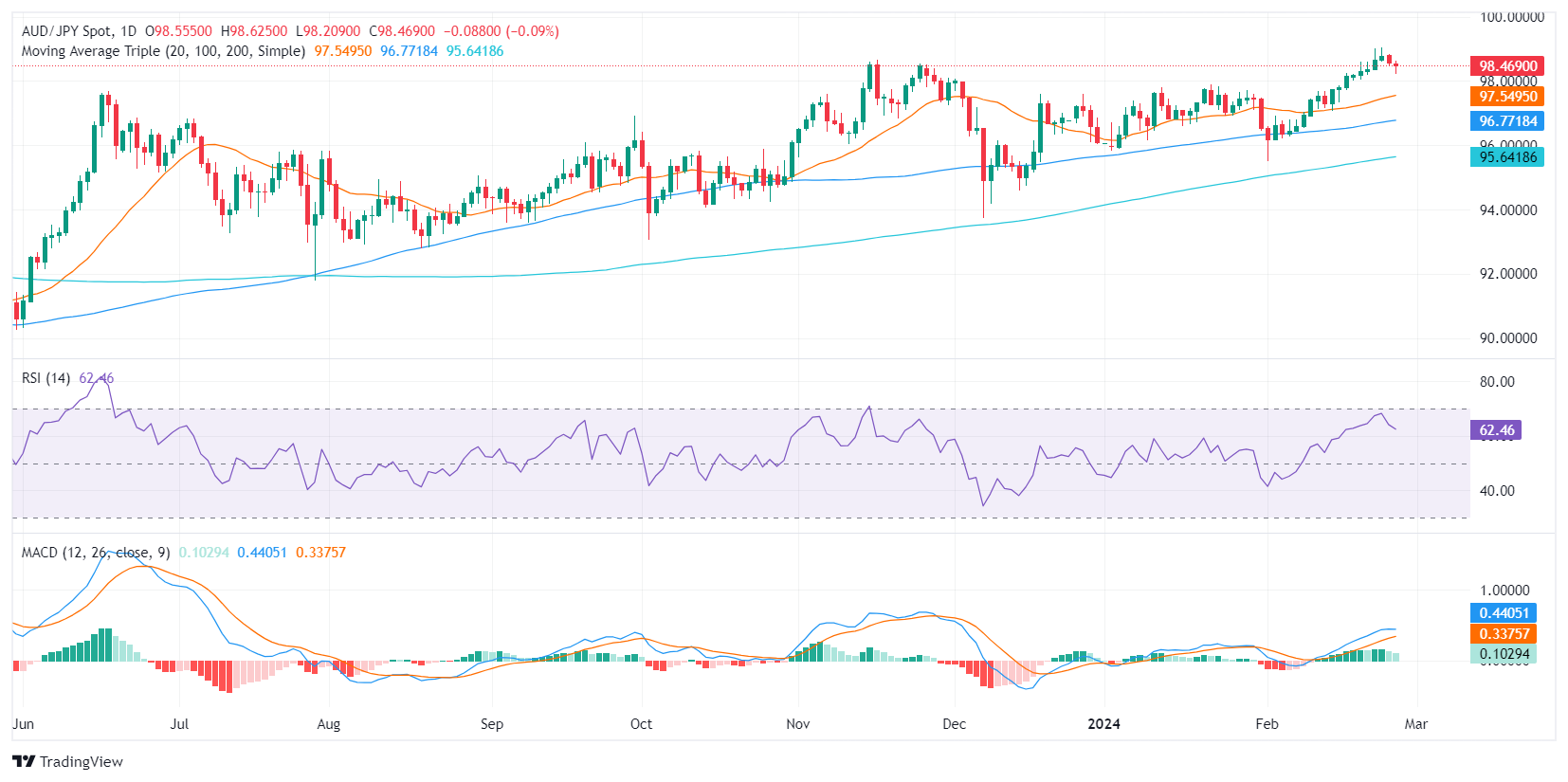
-
26.02.2024 17:49AUD/JPY Price Analysis: Bulls maintain dominance despite bearish hints unveiling
- The AUD/JPY is trading at 98.50, falling by 0.25% during Monday's session.
- Daily RSI for the AUD/JPY oscillates in the positive zone with a slight shift towards the sellers.
- On the hourly scale, the RSI settles in negative territory, signaling a short-term bearish correction.
- Indicators are consolidating the gains that took the pair to multi-year highs.
The AUD/JPY is currently trading at 98.50, with a slight dip of 0.25%. Based on the mix of indicators, the pair has a predominantly bullish bearing, although there are mild bearish hints on the shorter time frames. In that sense, the downward movements can be seen as a mere technical correction of the pair needed to consolidate the gains that took it to highs since 2015.
On the daily chart, considering the recent Relative Strength Index (RSI) values, the index shows a slight decline, implying a minor shift in favor of the sellers near the overbought zone. Nonetheless, the positioning in the above half domain indicates that buyers still exercise control. Turning to the daily Moving Average Convergence Divergence (MACD), the histogram's decreasing green bars signal fading positive momentum. Despite this deceleration, the positive color implies that the bulls may still have some fuel to counterattack the bearish pulls.
AUD/JPY daily chart
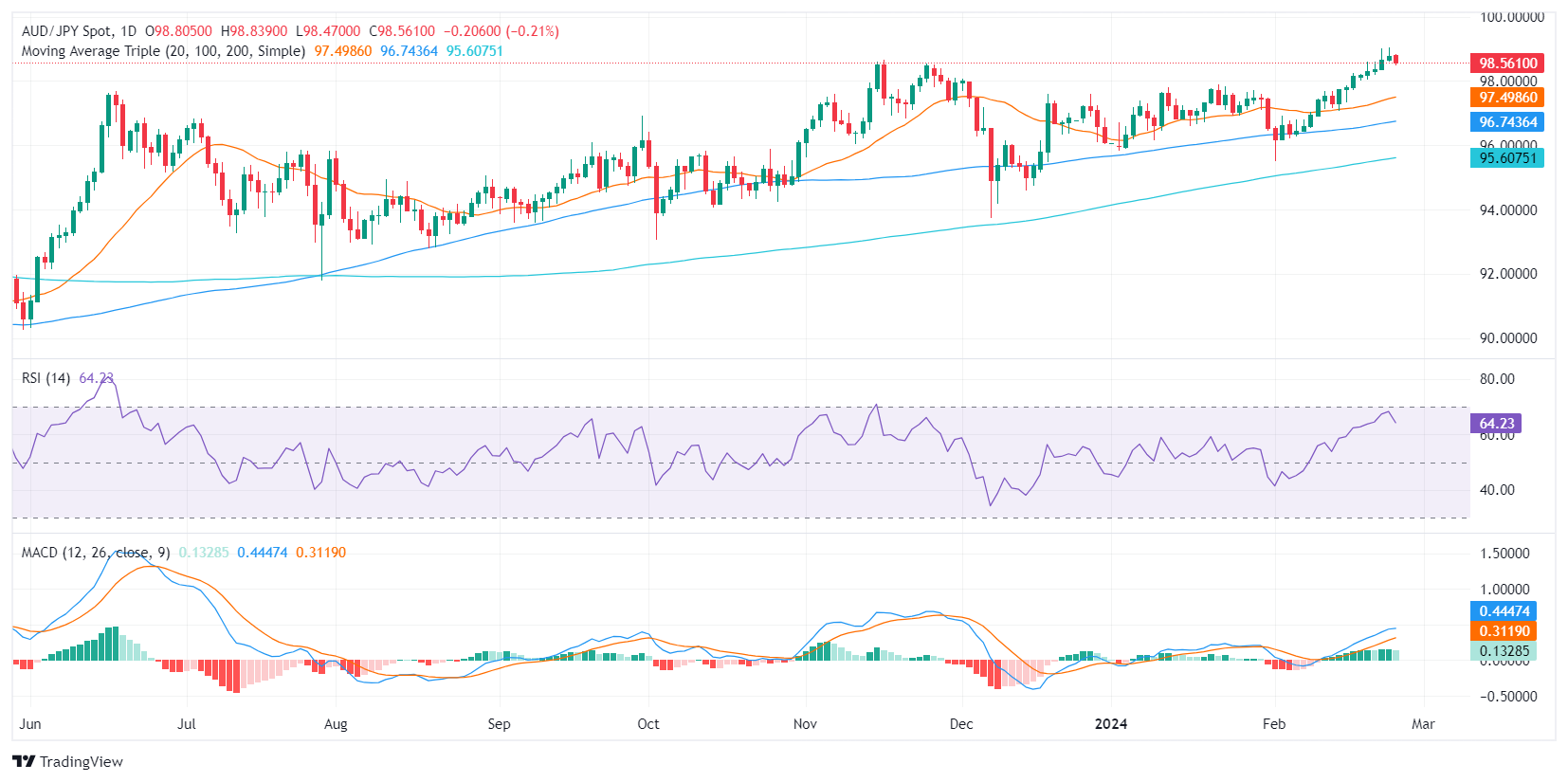
On an hourly chart, the RSI has settled into the negative band, depicting a conflicting scenario between the short-term and the broader perspective. Concurrently, the MACD histogram shows an uptrend but it is characterized by red bars, pointing to a build-up of negative momentum.
AUD/JPY hourly chart
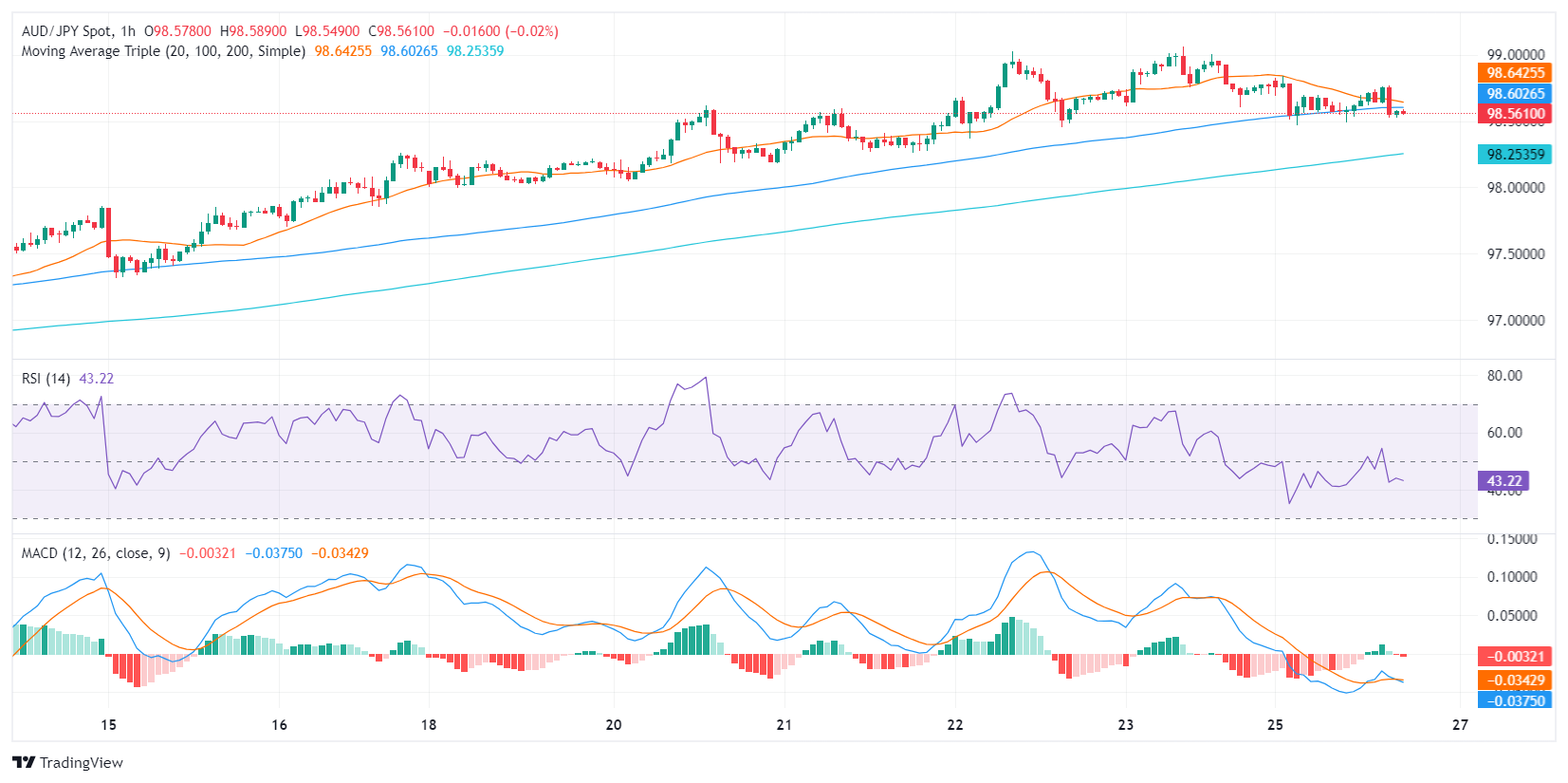
In summary, the AUD/JPY exhibits bullish signals from a general perspective, supported by its position above its main SMAs and positive territory representation by the daily RSI and MACD. However, bearish cues emerge on an hourly scale and maybe a warning that the bulls may take a breather in the next sessions to consolidate gains.
-
26.02.2024 04:15AUD/JPY drifts lower to snap eight-day winning streak to a multi-year top
- AUD/JPY kicks off the new week on a weaker note and moves away from a multi-year peak.
- Geopolitical risks and intervention fears underpin the JPY and exert pressure on the cross.
- The RBA’s hawkish outlook and BoJ policy uncertainty should help limit any further losses.
The AUD/JPY cross comes under some selling pressure during the Asian session on Monday and snaps an eight-day winning streak to the 99.00 mark, or its highest level since December 2014. Spot prices currently trade around the 98.60 region, with bears now awaiting a sustained break and acceptance below the 100-hour Simple Moving Average (SMA) before positioning for any further losses.
Against the backdrop of geopolitical risks, speculations that Japanese authorities will intervene to stem any further weakness in the domestic currency turn out to be a key factor behind the Japanese Yen's (JPY) relative outperformance. The Australian Dollar (AUD), on the other hand, is weighed down by the risk of a further escalation of tensions between China and Taiwan. This, in turn, is seen exerting some downward pressure on the AUD/JPY cross.
That said, the recent optimism led by hopes for additional stimulus from China might continue to act as a tailwind for the China-proxy Aussie. Apart from this, the Reserve Bank of Australia's (RBA) hawkish stance, signalling that policymakers are unwilling to rule out another cash rate increase in the wake of sticky inflation, could lend support to the AUD. This, in turn, warrants some caution before placing aggressive bearish bets around the AUD/JPY cross.
Meanwhile, a recession in Japan seems to have dashed hope for an imminent shift in the Bank of Japan's (BoJ) policy stance in the coming months. This could keep a lid on any meaningful appreciating move for the JPY and contribute to limiting the downside for the AUD/JPY cross. Hence, it will be prudent to wait for strong follow-through selling before confirming that spot prices have topped out and positioning for a deeper corrective decline.
-
23.02.2024 18:23AUD/JPY Price Analysis: Buyers hold sway with hints of increasing sell-off, cross still in multi-year highs
- The AUD/JPY is trading at 98.71, showing a slight gain during the Friday session still in highs since 2015.
- Daily RSI for the AUD/JPY suggests bullish momentum with a slight increase in the positive area.
- Divergences are observed between the hourly and daily charts where the latter signals buyers' dominance whilst the hourly chart indicates rising short-term selling pressure.
In Friday's session, the AUD/JPY pair is trading at 98.715, reflecting a slight increase in buying pressure. The daily chart signals that the buyers are in control but that bears are starting to wake up, while in the hourly chart, the consolidation is more evident with indicators losing ground.
On the daily chart, the Relative Strength Index (RSI) pair shows a positive stance, signifying the dominance of buyers. This can be inferred from RSI territory, which consistently remains positive, despite a marginal downtrend observed within the positive territory. This suggests a slight increase in selling pressure, however, buyers continue to hold dominance given the RSI's positive territory position.
Concurrent with this, the daily Moving Average Convergence Divergence (MACD) is exhibiting flat green bars. This indicates that the momentum of the market is neutral on the surface, yet further scrutiny reveals that buyers hold the upper hand as the pair lingers above the 20, 100, and 200-day Simple Moving Averages (SMAs).
AUD/JPY daily chart
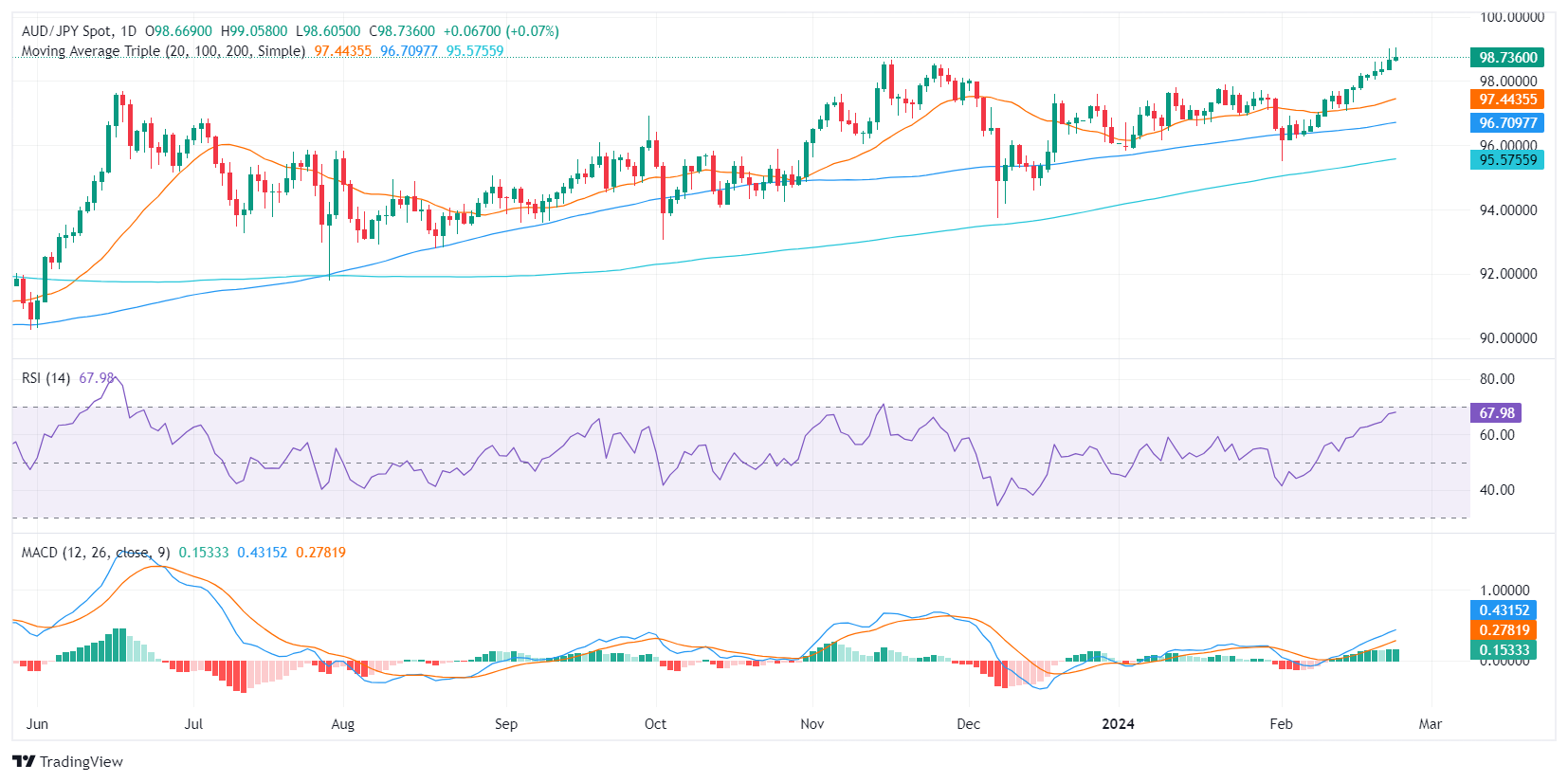
Upon examining the hourly chart, the RSI's position has diverted into negative territory while the MACD presents rising red bars suggesting a surge in selling pressure in the short term, contrasting the positive bias observed in the daily chart.
AUD/JPY hourly chart
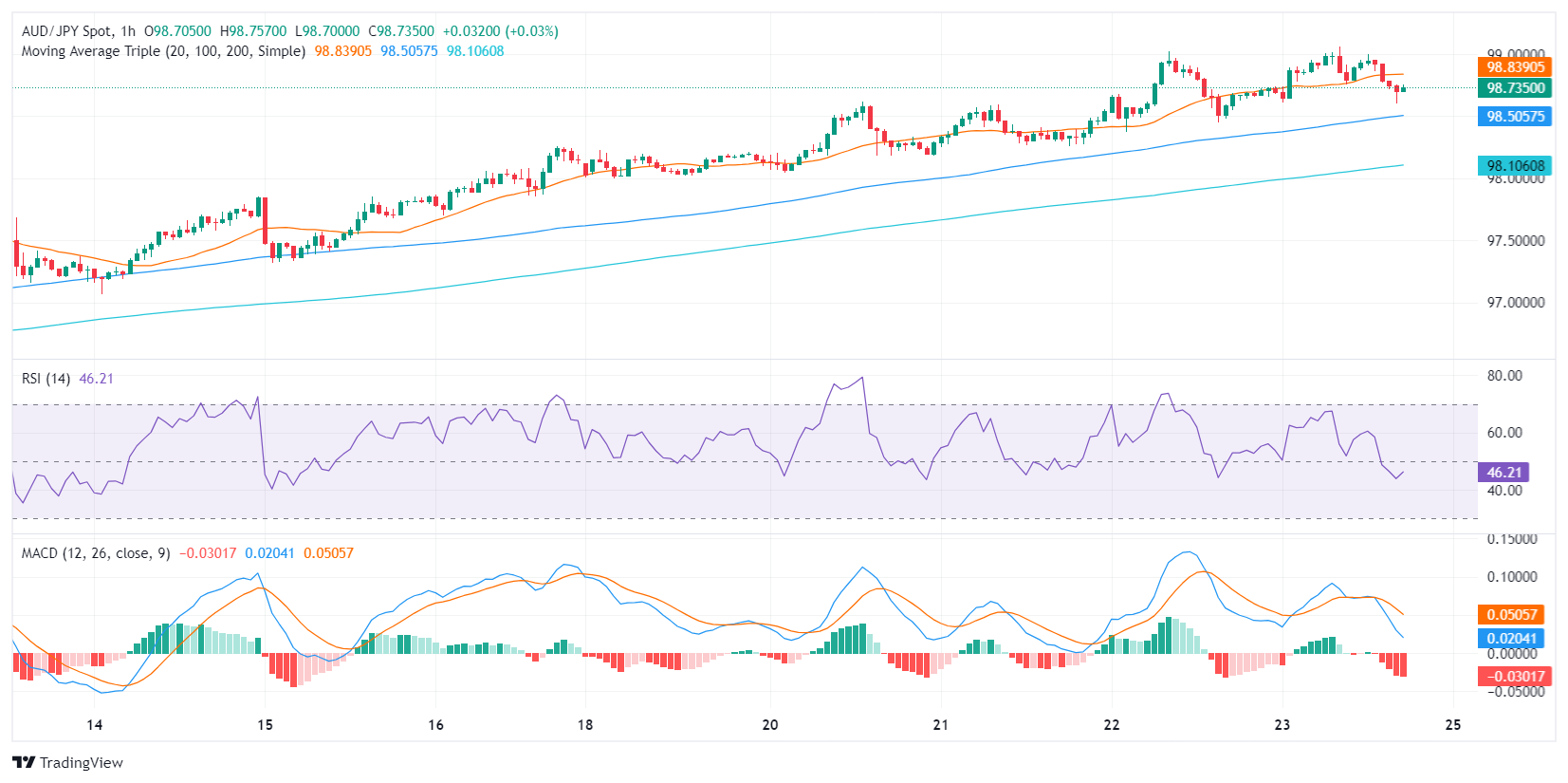
Conclusively, despite a short-term rise in selling pressure observed in the hourly chart, the longer-term daily chart suggests that buyers continue to control the market, fortified by the pair's position above the 20, 100, and 200-day SMAs.
-
23.02.2024 08:55AUD/JPY surges to all-time high near 99.00 on improved Australian private sector activity
- AUD/JPY surged to an all-time high as the Australian ASX 200 Index rose higher.
- BoJ could delay the plan of exiting from negative rates as Japan entered into a technical recession.
- Australian Dollar strengthened as recent PMI data indicated that February's economic activity returned to growth.
AUD/JPY rises to an all-time high near 99.00 during the European session on Friday, extending its winning streak that commenced on February 14. Market participants are concerned about the potential delay in the Bank of Japan's (BoJ) plan to exit from negative interest rates in the near term, particularly after last week's data showed that the Japanese economy entered into a technical recession. This downward pressure on the Japanese Yen (JPY) provides support for the AUD/JPY cross.
Furthermore, the surge in global money markets, as investors digest dashed hopes for interest rate cuts by major central banks worldwide, is exerting downward pressure on the safe-haven Japanese Yen (JPY). Conversely, Australia’s S&P/ASX 200 index moved higher following the overnight surge on Wall Street, which provides upward support for the Australian Dollar (AUD). This collective dynamic is contributing to the strength of the AUD/JPY cross.
Furthermore, investors persist in borrowing Japanese Yen (JPY) to invest in higher-yielding assets denominated in other currencies. However, recent verbal intervention by Japanese authorities may offer some support for the JPY. Vice Finance Minister for International Affairs Masato Kanda stated last week that authorities would take necessary actions if required.
Earlier in the week, the Japanese Yen received a boost from better-than-expected Trade Balance figures released by the Ministry of Finance of Japan. Market participants are now eagerly awaiting the release of Japan’s National Consumer Price Index (CPI) data scheduled for Tuesday.
The Australian Dollar (AUD) received upward support from domestic PMI data indicating that private sector activity returned to growth in February for the first time in five months, driven by a robust expansion in the services sector. Furthermore, the Aussie Dollar was buoyed by market sentiment suggesting the likelihood of no immediate rate cuts following the recent Meeting Minutes from the Reserve Bank of Australia (RBA).
-
22.02.2024 19:42AUD/JPY Price Analysis: Bullish momentum escalates and the cross reaches multi-year highs
- The AUD/JPY is currently trading at 98.648, marking a 0.20% increase in Thursday's session.
- The daily RSI for AUD/JPY suggests bullish momentum with an upward trend, indicating buyers are in charge.
- Despite intraday market volatility, the hourly RSI stays in the positive territory, underlining buyer's dominance.
- AUD/JPY's position above its main moving averages confirms the bullish outlook.
The AUD/JPY pair was seen trading at 98.648, marking a mild gain of 0.20% and reaching its highest level since 2015. The pair predominantly exhibits a bullish bias, per the insights from the Relative Strength Index (RSI) and Moving Average Convergence Divergence (MACD) on the daily chart. The RSI portrays a progressive uptrend, indicating consistent strengthening over recent sessions. This is further confirmed by the ascending green bars on the MACD histogram, signifying a favorable momentum. Despite some intraday fluctuations, the pair remains firmly in the hands of the buyers, being well positioned above the key Simple Moving Averages (SMAs) of 20,100 and 200 days.
The hourly RSI values paint a similar picture, despite some intraday volatility seen in the market. Although the RSI didn't maintain its position within the positive territory at all hours, it did stay above the negative zone, reflecting an overall bullish intraday sentiment.
In conclusion, despite some short-term uncertainties, the general outlook for the AUD/JPY pair seems bullish given the positive RSI values and rising MACD histogram. Whether looking at the daily or hourly chart, the momentum remains firm for the buyers, supported by the pair's position well above its primary moving averages.
AUD/JPY daily chart
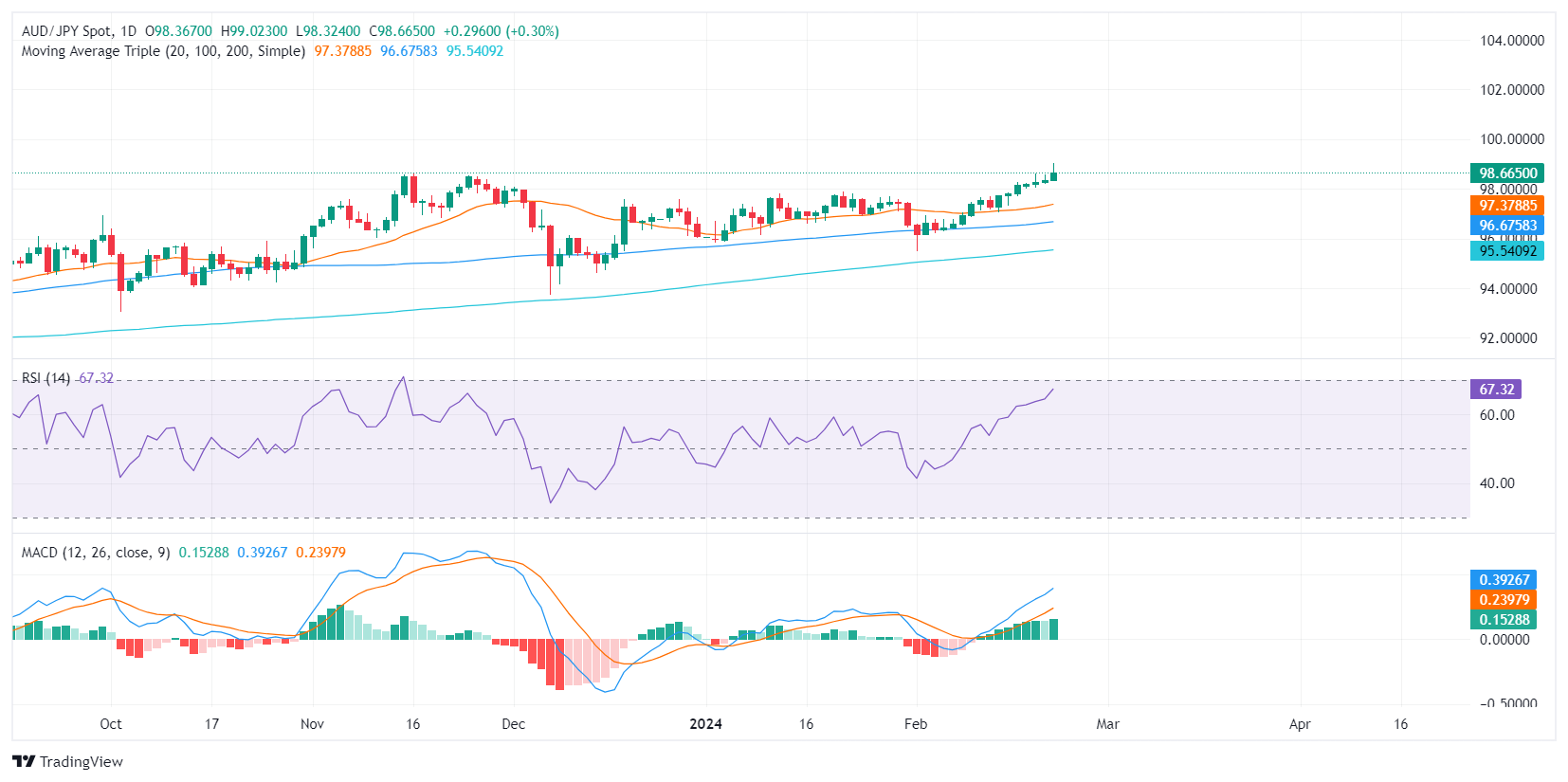
AUD/JPY hourly chart
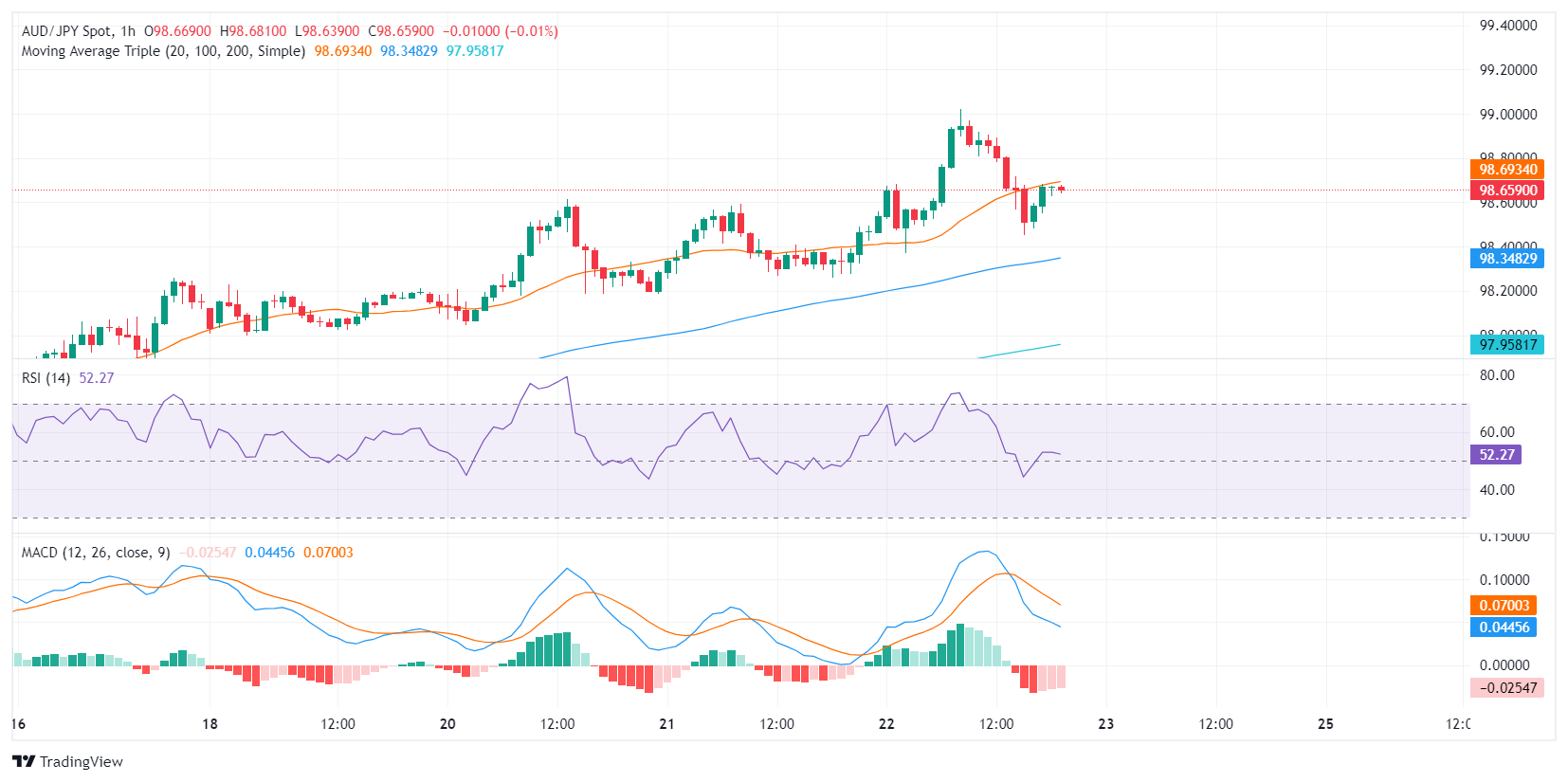
-
21.02.2024 19:52AUD/JPY price analysis: Bulls hold their ground, near-term pullback signalled
- The AUD/JPY trades on gains at 98.33 in Wednesday's session.
- Daily RSI for AUD/JPY suggests bullish momentum with a rising tendency and positive MACD.
- Hourly chart signals possible short-term bearish correction in a bullish bias.
- AUDJPY operating above key SMAs indicates long-term bullish sentiment.
In Wednesday's session, the AUD/JPY pair was spotted making moderate gains, trading at the 98.33 level. The technical landscape exhibits a generally bullish sentiment, boosted by positive momentum in the daily Relative Strength Index (RSI) RSI and Moving Average Convergence Divergence (MACD) histogram. However, a contrasting short-term bearish bias can be glimpsed on the hourly charts, suggesting possible corrective phases. Despite this, the prevailing upward drive exemplified by the pair's position above key SMAs aligns the broader perspective with the bulls.
The daily RSI for the AUDJPY pair hovers in the positive territory with a rising tendency indicating growing bullish momentum in the market. Meanwhile, the MACD histogram prints green bars, signifying positive momentum, and presents an incline that confirms the increasingly bullish sentiment.
AUD/JPY daily chart
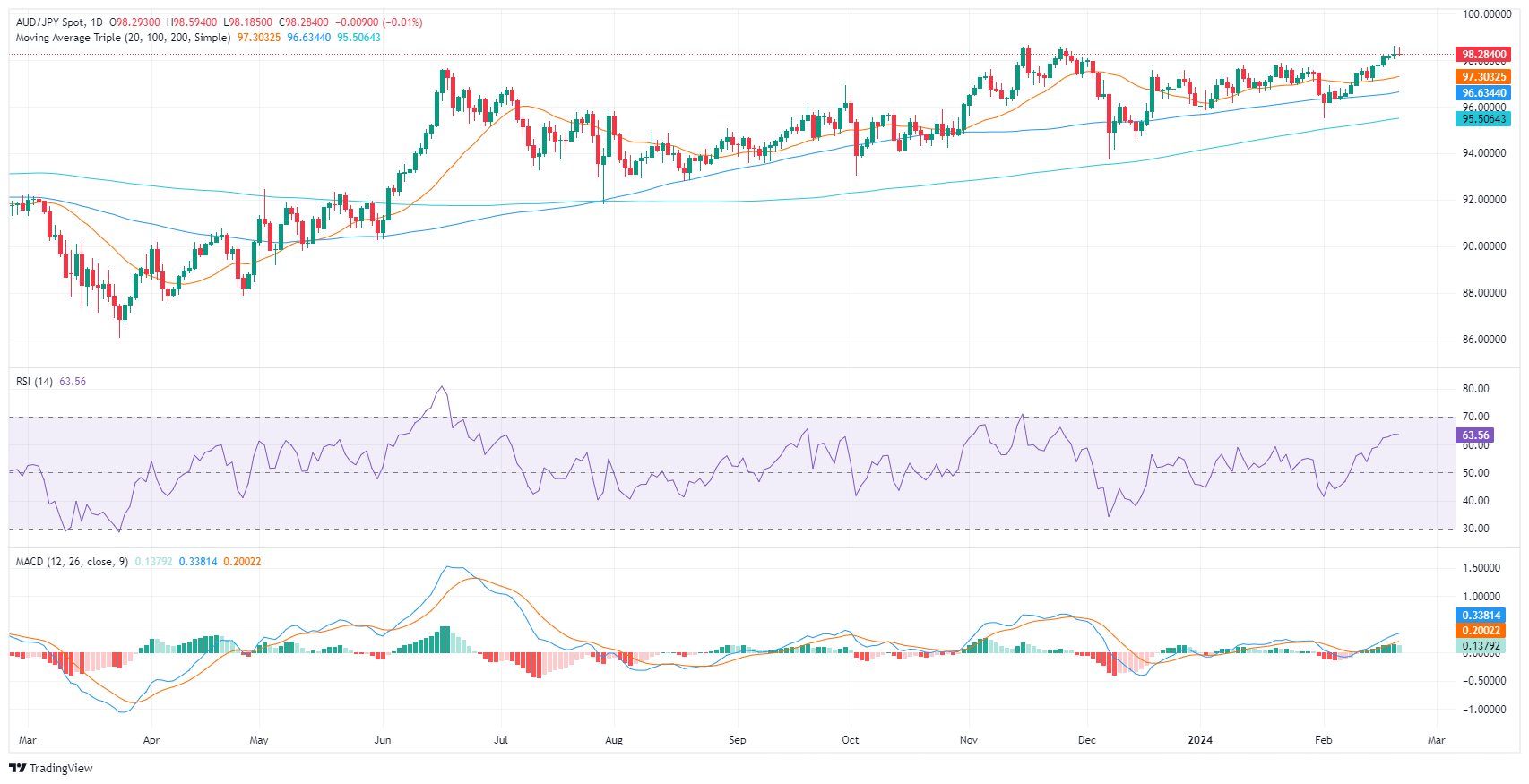
Switching to the hourly perspective, the RSI trends lower into the negative territory. This divergence in the RSI values on the daily and hourly charts could hint at a near-term corrective bearish phase within the dominant bullish bias. The MACD histogram here is currently falling, producing red bars, suggesting a slightly stronger negative momentum in the vicinity.
AUD/JPY hourly chart
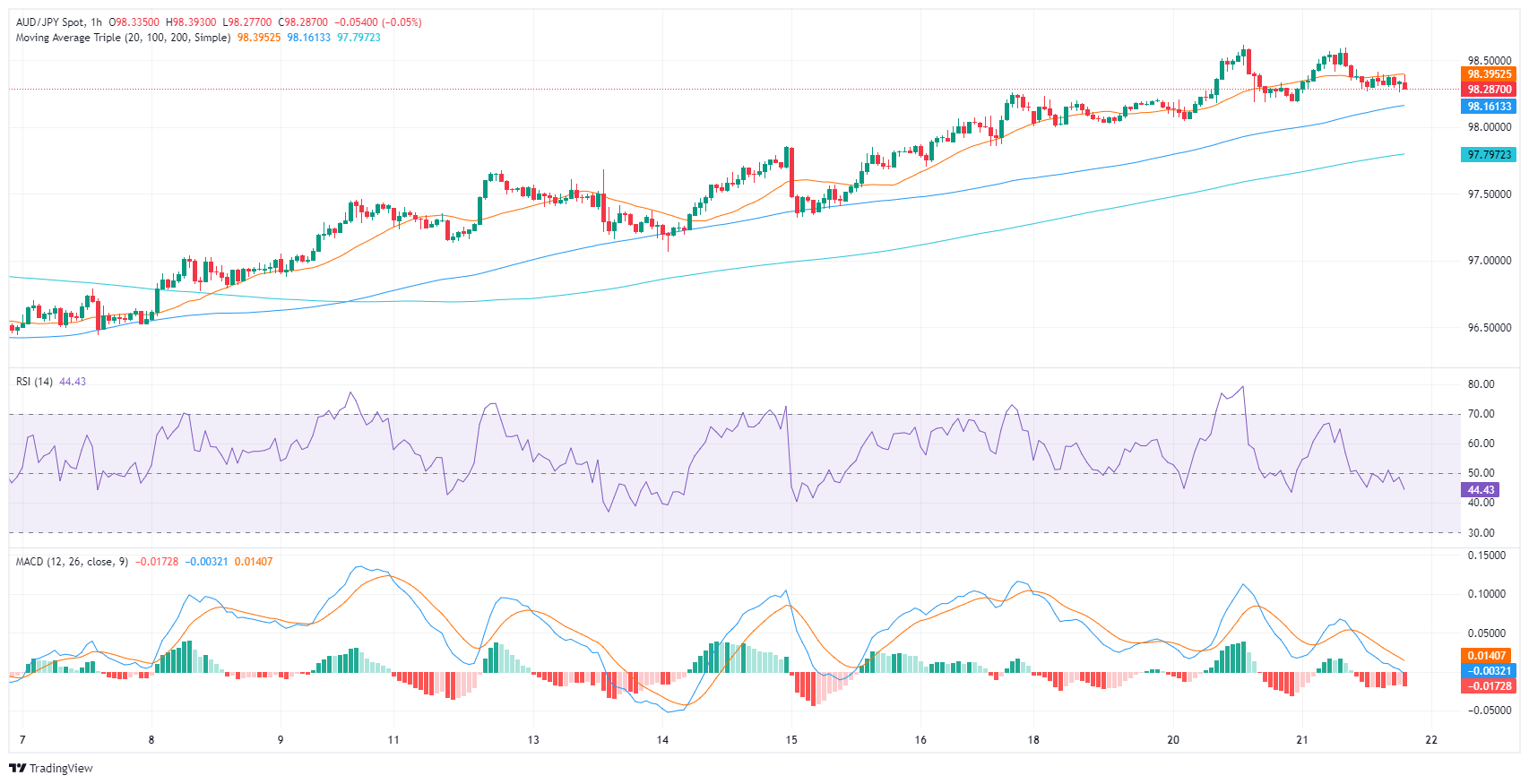
However, on a broader outlook, with the AUD/JPY operating above its primary SMAs (20, 100, 200-day), indicates the long-term sentiment favors the bulls. Thus, any short-term weakness might be perceived as a healthy technical correction.
-
21.02.2024 03:28AUD/JPY improves to near 98.40, Japan’s Trade Balance Total falls less than anticipated
- AUD/JPY continues to gain on expected RBA’s hawkish stance about interest rates trajectory.
- Australian Dollar could face hurdles amid softer S&P/ASX 200 Index.
- Japan’s Merchandise Trade Balance Total declined by ¥1,758.3B against the expected deficit of ¥1,925.9B.
AUD/JPY extends its winning streak for the sixth consecutive day as the Australian Dollar (AUD) strengthens against the Japanese Yen (JPY) following the Reserve Bank of Australia's (RBA) meeting minutes, which has transformed market bias towards the possibility of no rate cuts soon. The AUD/JPY cross trades higher around 98.40 during the Asian hours on Wednesday.
The Australian Dollar (AUD) could face hurdles amid softer Aussie financial markets, as the S&P/ASX 200 Index sees its second successive decline, mirroring losses on Wall Street overnight. This downturn is primarily linked to sluggish performance in mining stocks and metal prices.
Additionally, the Australian Bureau of Statistics has unveiled mixed data on the Wage Price Index for the fourth quarter, with little observable impact on the Australian Dollar (AUD).
On the other side, the Ministry of Finance of Japan reported a Trade Balance figure better than expected, potentially supporting the Japanese Yen and thereby limiting gains in the AUD/JPY cross. Japan’s Merchandise Trade Balance Total showed a deficit of ¥1,758.3B in January, against the anticipated deficit of ¥1,925.9B and the previous reading of ¥68.9B.
Moreover, Imports (YoY) declined by 9.6%, greater than the expected drop of 8.4% and the previous decrease of 6.9%. However, Exports surged by 11.9% year-over-year, surpassing both the predicted 9.5% and the prior 9.7%.
On Tuesday, Japanese Finance Ministry official Atsushi Mimura indicated that the government is engaged in discussions with other nations regarding FX intervention. This stance may have provided some bolstering for the JPY.
-
20.02.2024 12:07AUD/JPY rises to near 98.50 as RBA could maintain its current rates throughout 2024
- AUD/JPY extends gains on hawkish market sentiment about RBA interest rates trajectory.
- The Australian Dollar faces pressure as the S&P/ASX 200 halted its winning streak on Tuesday.
- Japanese official Atsushi Mimura talked about connecting to other countries regarding FX intervention.
AUD/JPY continues its upward trajectory for the fifth consecutive session on Tuesday, with the pair edging higher around 98.50 during European trading hours. The Australian Dollar (AUD) receives support against the Japanese Yen (JPY) as market sentiment leans towards the expectation of a resilient Australian economy, backed by low unemployment and healthy corporate sector balance sheets. Westpac anticipates that the Reserve Bank of Australia (RBA) will maintain its current monetary policy stance throughout 2024 and adopt a less restrictive approach in 2025.
However, the Australian Dollar (AUD) faced downward pressure from a weaker Aussie money market. The S&P/ASX 200 index halted its winning streak, with declines in mining and energy stocks amid weaker commodity prices, potentially limiting the advance of the AUD/JPY cross.
The Reserve Bank of Australia (RBA) released the minutes from its February monetary policy meeting. During the meeting, the RBA Board deliberated on the possibility of raising rates by 25 basis points (bps) or keeping rates unchanged.
Although recent data provided the board with increased confidence that inflation would return to target within a reasonable timeframe, there was acknowledgment that it would "take some time" before the board could be sufficiently confident about inflation. As a result, the board agreed that it was appropriate not to rule out another rate hike, indicating a cautious approach to future monetary policy decisions.
On Japan’s side, Japanese Finance Ministry official Atsushi Mimura said that the government is in communication with other countries regarding FX intervention." He mentioned that the government can sell assets such as savings and foreign bonds in FX reserves when intervention is required.
Furthermore, Finance Minister Shunichi Suzuki expressed concerns about the negative implications of a weak Yen. In an earlier interview, Suzuki noted, "The Bank of Japan (BoJ) holds jurisdiction over monetary policy. But there will come a time when interest rates rise." Market participants are likely to focus on Japan’s Trade Balance data, including Import and Export figures for January, which are scheduled to be released on Wednesday.
-
19.02.2024 11:40AUD/JPY retraces its gains on improved Japan Machinery Orders, trades around 98.10
- AUD/JPY halts its winning streak that began on Wednesday.
- Japanese Finance Minister Shunichi Suzuki restated that interest rates will go up.
- The higher S&P/ASX 200 index supported the Australian Dollar.
AUD/JPY snaps its three-day winning streak, trading lower around 98.10 during the European trading hours on Monday. The Japanese Yen (JPY) gains ground against the Australian Dollar (AUD) on the back of improved Machinery Orders data from Japan, which in turn, undermines the AUD/JPY pair. Moreover, Japanese Finance Minister Shunichi Suzuki reiterated that “The Bank of Japan (BoJ) holds jurisdiction over monetary policy. But there will be a phase when interest rates go up”.
Japan’s Machinery Orders (MoM) increased by 2.7%, surpassing expectations of 2.5% in January, rebounding from the previous decline of 4.9%. Meanwhile, the year-over-year data showed a decline with an improved reading of -0.7%, better than the anticipated -1.4% reading and the prior decline of -5.0%. These numbers indicate a boost in business confidence within Japan’s manufacturing sector.
On the other side, the Australian Dollar likely received support from the higher S&P/ASX 200 index on Monday, which reached an all-time high, driven by increased mining stocks amid stronger metals prices. This positive market sentiment could further strengthen the Aussie Dollar, consequently bolstering the AUD/JPY cross, as investors believe that the Reserve Bank of Australia (RBA) will maintain its current monetary policy stance throughout 2024.
Westpac expects a resilient Australian economy, supported by low unemployment and healthy corporate sector balance sheets. However, Westpac anticipates the RBA to adopt a less restrictive approach in 2025.
Reserve Bank of Australia Governor Michele Bullock addressed the Australian parliament's Senate Economics Legislation Committee in the last week, acknowledging that the global economy has performed better than initially anticipated. She highlighted previous concerns about potential hard landings and recessions but indicated that the economy is currently in a favorable position to bring inflation down within a reasonable timeframe.
-
16.02.2024 12:15AUD/JPY moves in an upward direction to near 98.00 after dovish remarks from BoJ Ueda
- AUD/JPY extends its winning streak after dovish comments from BoJ Governor Kazuo Ueda.
- BoJ Governor Ueda expects monetary conditions in Japan to remain accommodative.
- The higher S&P/ASX 200 index helped the Australian Dollar to hold ground.
AUD/JPY continues its winning streak for the third successive day, extending higher to near 98.00 during the European session on Friday. The dovish Friday’s remarks from the Bank of Japan (BoJ) Governor Kazuo Ueda weigh on the Japanese Yen (JPY) and, consequently, act as a tailwind for the AUD/JPY cross. He stated that monetary conditions in Japan are expected to remain accommodative in relevance to the current economic and price outlook.
On Thursday, the downbeat Gross Domestic Product (GDP) data confirmed that Japan’s economy has entered into a technical recession. This cements the speculation that the Bank of Japan (BoJ) may postpone exiting its negative interest rate policy, pushing investors to move away from the safe-haven Japanese Yen.
The Australian Dollar (AUD) received upward support from the S&P/ASX 200 index’s improvement tracking the overnight surge in Wall Street. The Australian economy has shown modest growth, influenced by ongoing challenges in the labor market and subdued inflationary pressures.
Moreover, the latest Aussie employment data could prevent the Reserve Bank of Australia (RBA) from pursuing further interest rate hikes in the upcoming March meeting. However, Market sentiment indicates that the RBA will likely hold its current interest rates until August and may initiate a loosening policy with 25 basis points (bps) in September.
-
15.02.2024 19:36AUD/JPY price analysis: Bulls dominate momentum and clear daily losses
- The AUD/JPY is currently trading at 97.70 with mild gains in the Thursday session after bottoming at a low of 97.30.
- Daily chart indicators suggest that the buyers are in control of short-term price movement.
On Thursday, the AUD/JPY pair was rebounding from a daily low of 97.30 to 97.70 suggesting that the bulls are controlling the movement. The overall trend is also positive as the cross holds above the main Simple Moving Averages (SMAs).
On the daily chart, the Relative Strength Index (RSI) for the pair is currently in positive territory, indicating a positive momentum. The RSI has been trending slightly higher over the past few days, suggesting that buyers continue to dominate the market. In addition, the Moving Average Convergence Divergence (MACD) histogram is showing a rising trend, with green bars indicating positive momentum further supporting the positive outlook. Looking at the larger context, the AUDJPY pair remains above the 20, 100, and 200-day Simple Moving Averages (SMAs), indicating a bullish overall trend. This further supports the positive outlook for the pair.
AUD/JPY daily chart

-
15.02.2024 06:31AUD/JPY loses traction below 97.50 amid the weaker Australian employment data
- AUD/JPY faces some selling pressure near 97.43 following the downbeat Australian employment data.
- The Australian Unemployment Rate rose to 4.1%, the highest since January 2022.
- Japan's economy entered a technical recession after shrinking in the fourth quarter (Q4) of 2023.
The AUD/JPY cross loses momentum during the early European trading hours on Thursday. The downtick of the cross is supported by surprisingly weak Australian January employment data. AUD/JPY currently trades around 97.43, down 0.33% on the day.
The Australian Unemployment Rate rose to a two-year high, coming in at 4.1% in January from the previous reading of 3.9%, worse than the market expectation of 4.0%. The report suggested that the labor market was loosening in the face of a faltering economy and poor consumer demand, according to the Australian Bureau of Statistics (ABS) on Thursday. Meanwhile, the Australian Employment Change arrived at 0.5K in January versus -65.1K prior, below the market consensus of 30.0K.
This report has spurred speculation that the Australian central bank may adopt a dovish stance in response to the weakening economy, which exerts some selling pressure on the Aussie (AUD). The Reserve Bank of Australia (RBA) Governor Michele Bullock said on Thursday that RBA is in a good position to get inflation down in a reasonable amount of time.
On the other hand, Japan's economy entered a technical recession after shrinking again in the fourth quarter of 2023, according to preliminary data released from Japan’s Cabinet Office on Thursday. The GDP growth number contracted 0.1% QoQ in Q4 from a revised 0.8% contraction in the third quarter. This figure came in weaker than expectations of 0.3% expansion. Furthermore, the Annualized GDP contracted 0.4% YoY in Q4 versus the 1.4% expansion expected and 3.3% contraction prior.
Investors anticipate the Bank of Japan (BoJ) to abandon its negative interest rate regime at its April policy meeting, once the annual spring wage negotiations confirm a trend of considerable wage growth. However, the downbeat GDP report on Thursday implies that rising inflation threatens domestic demand and potentially supports the case for looser monetary policy for much longer.
In the absence of the top-tier economic data release from the Australian and Japanese docket later this week, the risk sentiment could drive the markets and influence the AUD/JPY cross. -
14.02.2024 11:58AUD/JPY rises to near 97.50 after hawkish remarks from Commonwealth Bank CEO
- AUD/JPY gains ground after the hawkish comments from the Commonwealth Bank.
- Commonwealth Bank CEO Matt Comyn mentioned that the RBA might delay rate cuts until early 2025.
- Japan’s Masato Kanda reiterated that authorities may intervene in the FX market if needed.
AUD/JPY edges higher to near 97.50 during the European session after experiencing a volatile session on Wednesday. The cross reversed intraday losses and entered into positive territory as the Australian Dollar (AUD) strengthened.
The hawkish remarks from Commonwealth Bank CEO Matt Comyn attracted some buyers for the Aussie Dollar and, consequently, acted as a tailwind for the AUD/JPY cross. He suggested that the Reserve Bank of Australia (RBA) might delay interest rate cuts until early 2025 due to steady inflation. Comyn's comments raised concerns about increased living costs for borrowers relying on tax cuts and mortgage relief.
However, the Australian Dollar faced downward pressure as the S&P/ASX 200 Index plunged to recent lows, driven by a selloff in mining and financial stocks following Wall Street's decline overnight in response to stronger-than-expected US inflation figures.
On the other side, Japan’s top currency diplomat Masato Kanda reiterated that authorities stand ready to intervene in the Forex market if necessary. This stance might have bolstered the Japanese Yen (JPY), consequently undermining the AUD/JPY cross during Wednesday's Asian session. Furthermore, Japan's Finance Minister Shunichi Suzuki said that rapid currency moves are undesirable and that the government is watching the market with stronger urgency.
Investors await the preliminary Q4 Gross Domestic Product (GDP) data 2023 due on Thursday. Investors forecast that the Japanese economy could show a growth of 0.3% after contracting by 0.7% in the third quarter.
-
13.02.2024 19:34AUD/JPY sees downside as markets continue shaping the RBA and BoJ’s policy expectations
- The AUD/JPY currently stands at 97.25, showing a 0.25% decrease in Tuesday's trading session.
- Japan's manufacturing activity remains weak with decreasing machine tool orders.
- RBA and BoJ's policy divergence may eventually make the cross recover.
On Tuesday's session, the AUD/JPY suffered modest losses, observed trading at around 97.25. The pair is positioned on turbulent waters as Australia's economic view is fogged with uncertainty while Japan battles with weak manufacturing activity. That being said, the divergent Reserve Bank of Australia (RBA) and Bank of Japan (BoJ) policies may limit the downside for the pair.
The Australian economy depicts an ambiguous outlook. On a positive note, Westpac's Consumer Sentiment index for February reached a 21-month high of 86.0, pointing towards buoyed consumer optimism. However, the National Australia Bank's (NAB) business survey showed a dip to a two-year low of 6 in January, signaling a softer economic environment. In addition, elevated inflation risk levels persist, with RBA's Head of Economic Analysis Kohler remarking that while inflation is decreasing, it will take time to hit the RBA's 2%-3% target range and as for now the market predicts an 85% likelihood of Australia's first interest rate cut as late as in August, adjusted from June at the beginning of the month.
Turning to Japan, January's machine tool orders saw little improvement, falling 14.1% YoY, from -9.6% in December, reflecting a weak manufacturing activity. Notably, domestic orders dropped 29.1% YoY while foreign orders fell only 6.2% YoY, highlighting internal economic concerns. In addition, January PPI remaining steady at 0.2% YoY, signals a minimal pipeline price pressure. Regarding the Bank of Japan's policy, normalization looks set to occur after the spring wage negotiations if there is a confirmed pick-up in wage growth. In the meantime, markets anticipate a June liftoff, keeping a close eye on the economic revival which would demand a sooner liftoff.
AUD/JPY technical analysis
On the daily chart, the Relative Strength Index (RSI) data reveals that the bearish dominance is fading away as the RSI jumps above 50. A closer look at the Moving Average Convergence Divergence (MACD) histogram data reveals that the histogram has consistently printed decreasing red bars, indicating a falling negative momentum and now printing a green bar. These insights suggest that the seller’s momentum is waning with bulls gradually taking over.
AUD/JPY daily chart
-638434480978088229.png)
-
12.02.2024 19:29AUD/JPY Price Analysis: Bulls advance to multi-week highs, consolidation incoming
- The AUD/JPY rose in Monday's session at 97.60 with a gain of 0.23%.
- Hourly chart shows RSI and MACD dip, highlighting short-term buyers' shift to consolidate gains.
- The overall trend still favors the bulls.
In Monday's session, the AUD/JPY is trading at 97.60, registering a gain of 0.23%. The pair has seen a recent push from the buyers, which made indicators reach overbought territory and now indicators are consolidating. The overall trend still favors the buyers as the pair is still above its main Simple Moving Averages (SMAs)
Analyzing the daily chart, the Relative Strength Index (RSI), which resides within the positive territory, continues to show an increasing trend, suggesting that buyers are currently exerting pressure on the market. This aligns with the Moving Average Convergence Divergence (MACD) histogram, which printed a green bar implying that the bulls jumped back a into positive territory.
Concentrating on the hourly chart, the RSI dipped back from the overbought area struck earlier in the session to the positive domain, hinting at a more balanced, albeit still buyers-favoured, market in recent hours. In line with that, the MACD histogram has been rising, throughout the session but now seems to have flattened as buyers are taking a breather.
Taking the pairs' position into account relative to its main Simple Moving Averages (SMAs), the broader trend is on the buyer's side, as the pair is above the 20, 100, and 200-day SMAs. Yet, for the rest of the session, the cross may continue side-ways trade to consolidate the gains from its recent push.
AUD/JPY daily chart
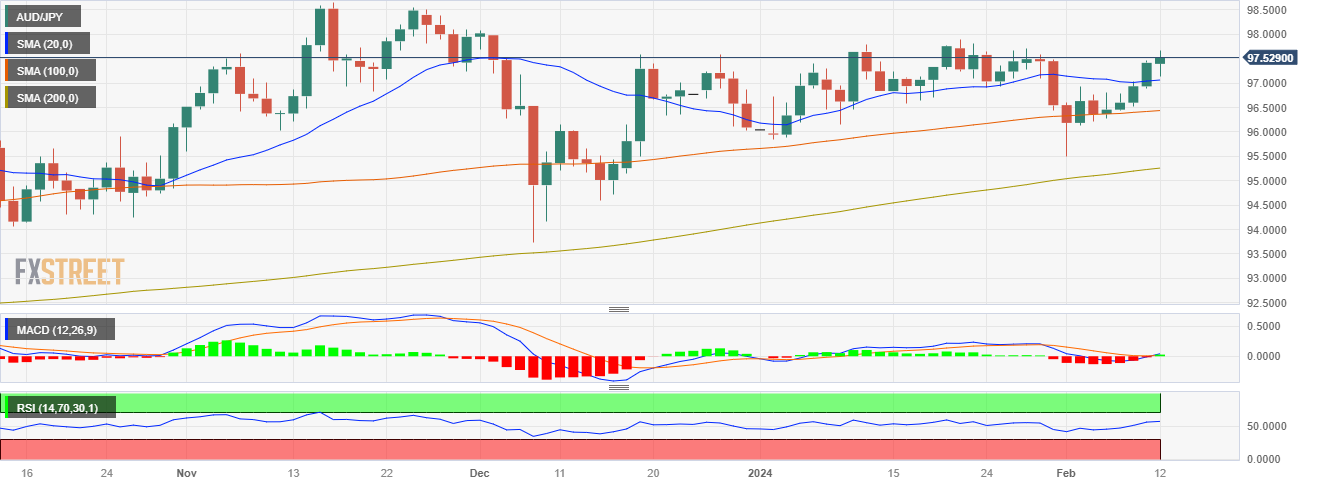
-
12.02.2024 06:10AUD/JPY retreats on market caution, stretches lower to near 97.30
- AUD/JPY halts its winning streak on cautious mood due to Middle East tension.
- The Middle East tension has escalated due to Israel’s conclusion of a series of strikes in southern Gaza.
- The Australian Dollar encountered challenges stemming from the decline in the Australian money market.
AUD/JPY snaps its four-day winning streak, which could be attributed to the market caution due to geopolitical conflict in the Middle East. The Japanese Yen (JPY) could have enjoyed the safe-haven status after Israel concluded a series of strikes in Gaza's southern city of Rafah. The AUD/JPY cross edges lower to near 97.30 during the Asian hours on Monday.
On Sunday, Israeli Prime Minister Binyamin Netanyahu expressed intentions to escalate the military operation there, but US President Joe Biden urged caution, insisting on a credible plan. Hamas also warned against a ground offensive in Rafah, fearing it could impact future hostage releases.
However, investor sentiment towards the Japanese Yen weakens as they perceive the Bank of Japan (BoJ) to adopt a cautious approach towards rate hikes following its departure from ultra-dovish monetary policy. BoJ Deputy Governor Shinichi Uchida's recent remarks suggest that the central bank is unlikely to pursue aggressive tightening, even after abandoning negative interest rates.
The increase in Chinese New Loans, reported on Friday, signifies a positive development for economic activities in China. This might have potentially offered support for the AUD/JPY pair. The close trade relations between China and Australia might have amplified this effect. However, with Chinese markets closed for the Lunar New Year holidays, the impact may be limited in the short term.
Meanwhile, the Australian Dollar (AUD) encountered challenges stemming from the decline in the Australian money market. Despite a record surge in United States (US) markets on Friday, the share market in Australia trended lower in early trading on Monday, constraining the Aussie Dollar's performance, which in turn, helped to undermine the AUD/JPY pair.
-
09.02.2024 19:47AUD/JPY bulls gain ground as RBA and BOJ monetary policies diverge
- The AUD/JPY pair stands at 97.409 showing 0.50% gains in the last session of the week.
- The main reasons for the upward movements are the divergent RBA and BoJ monetary policy, which benefit the Aussie.
- Daily Chart indicators show strong buying momentum while four-hour indicators flash overbought conditions.
- Despite the looming correction, the overall trend is bullish.
In Friday's session, the AUD/JPY was observed rising to 97.40, registering a t gain of 0.50. This performance is primarily shaped by the contrasting economic stances of the Reserve Bank of Australia (RBA) and the Bank of Japan (BOJ). With the daily chart indicating a bullish momentum and the bulls asserting their dominance, the prevailing outlook seems positive. However, the four-hour chart shows indicators have entered the overbought zone, suggesting a potential for imminent correction.
In line with that, recent statements by the RBA Governor Bullock suggest a balanced perspective with the potential for future interest rate changes. The possibility remains open for both an increase or a standstill, subject to inflation and economic growth. The market expects the RBA's first rate cut in August, with a total easing of 50 bp anticipated for the year. In contrast, the Bank of Japan BoJ maintains a dovish stance, with Governor Ueda affirming that accommodative financial conditions may continue after the current negative rates era. As per the latest data, the likelihood of rate liftoff from the BoJ is forecasted for June, with only 25 bps of tightening for the rest of 2024, and as long as markets bet on a dovish BoJ, the pair may see further upside.
AUD/JPY technical analysis
On the daily chart, the Relative Strength Index (RSI) boasts a positive trajectory within positive territory, suggesting buyers maintain control in line with the Moving Average Convergence Divergence (MACD) histogram which reveals diminishing red bars, suggesting that the buyers are in command. On a broader perspective, the pair resides above the 20-day, 100-day, and 200-day Simple Moving Averages (SMAs). This emphasizes that bullish forces hold a firm grip on the larger time frames with the bears nowhere to be found.
AUD/JPY daily chart
-638431046503469120.png)
Moving to the four-hour chart, the momentum switches somewhat. Key performance indicators have approached overbought levels, suggesting an imminent correction. A closer look at the RSI confirms this forecast as it ventures into overbought territory. The MACD confirms this pattern as well, with its green bars gradually shrinking. In summary, whilst the bulls seem to be gaining ground currently, an impending correction looms as short-term momentum indicators align to suggest a pullback.
-
09.02.2024 08:57AUD/JPY rises to near 97.20 after dovish remarks from the BoJ Governor Kazuo Ueda
- AUD/JPY gains ground as market sentiment turned bearish on dovish BoJ’s remarks.
- Bank of Japan (BoJ) Governor Kazuo Ueda stated that accommodative conditions are expected to continue even if negative rates are abandoned.
- IMF suggests that Japan should adopt tighter fiscal policy measures and gradually phase out monetary stimulus initiatives.
- The intraday recovery in the Australian money market supports the AUD.
AUD/JPY moves on an upward trajectory for the fourth consecutive session, edging higher to near 97.20 during the European hours on Friday. The sentiment of the JPY’s traders shifted to bearish following the dovish remarks from Bank of Japan (BoJ) Deputy Governor Uchida Shinichi on Thursday. He stated that the central bank would not pursue aggressive rate hikes upon ending negative rates.
Moreover, BoJ Governor Kazuo Ueda commented on Friday, expressing that accommodative conditions are likely to persist even if negative rates are abandoned. He emphasized the importance of monitoring the health of the BoJ balance sheet as the exit from stimulus policy approaches.
The International Monetary Fund (IMF) released its findings following its annual policy consultation with Japan and the Bank of Japan. The report indicates that upside risks to inflation have materialized over the past year. It recommends that Japan should tighten fiscal policy and gradually wind down monetary stimulus measures.
First Deputy Managing Director of the International Monetary Fund, Gita Gopinath, elaborated further, stating that if the BoJ proceeds gradually with clear communication, increases in short-term rates should not result in significant global spillovers. Gopinath also suggests that the BoJ can smoothly transit away from negative rates, given the market's perception that real borrowing costs will remain very low.
The AUD/JPY cross encountered challenges as the S&P/ASX 200 index trended negatively during the early trading hours of Friday, accompanied by declines in coal and iron ore prices. However, the Australian money market managed to recover intraday losses and shift into positive territory, potentially providing support for the Australian Dollar (AUD). This positive momentum for the AUD may act as a tailwind for the AUD/JPY cross.
Reserve Bank of Australia (RBA) Governor Michele Bullock addressed parliament, noting that recent inflation developments are encouraging, but there is still progress needed to meet the target. Bullock also mentioned that if consumption slows faster than anticipated, there would be an opportunity to consider rate cuts. Furthermore, the Commonwealth Bank of Australia (CBA) predicted a reduction of 75 basis points in the benchmark interest rate for 2024, with the first cut expected in September.
© 2000-2024. All rights reserved.
This site is managed by Teletrade D.J. LLC 2351 LLC 2022 (Euro House, Richmond Hill Road, Kingstown, VC0100, St. Vincent and the Grenadines).
The information on this website is for informational purposes only and does not constitute any investment advice.
The company does not serve or provide services to customers who are residents of the US, Canada, Iran, The Democratic People's Republic of Korea, Yemen and FATF blacklisted countries.
Making transactions on financial markets with marginal financial instruments opens up wide possibilities and allows investors who are willing to take risks to earn high profits, carrying a potentially high risk of losses at the same time. Therefore you should responsibly approach the issue of choosing the appropriate investment strategy, taking the available resources into account, before starting trading.
Use of the information: full or partial use of materials from this website must always be referenced to TeleTrade as the source of information. Use of the materials on the Internet must be accompanied by a hyperlink to teletrade.org. Automatic import of materials and information from this website is prohibited.
Please contact our PR department if you have any questions or need assistance at pr@teletrade.global.















